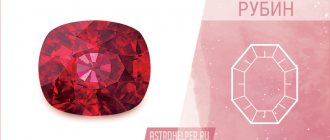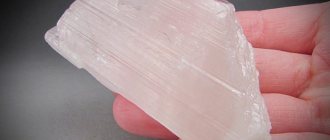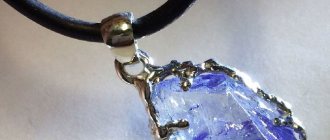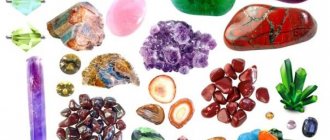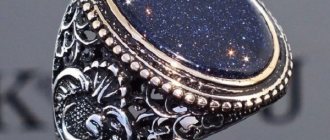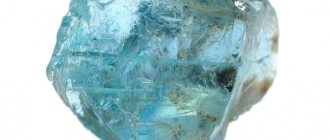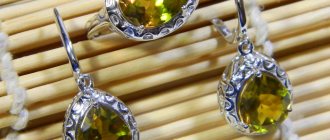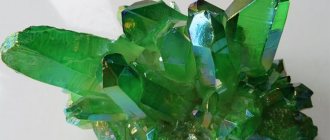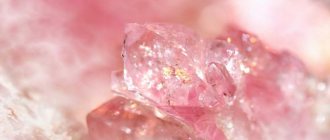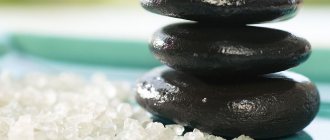Ruby is, in fact, the king among precious stones, and looks the part. The gem is blood-red in color and looks the part. By the way, Gem translated from Latin means “RED”.
A high quality gem looks something like this. It has a smooth surface without any defects. Has significant weight. It always sparkles and shines. It has a deep red color and may contain milky inclusions.
This stone is a sign of love; it speaks of the desire for life and health. He has immeasurable power and cannot stand lies.
A little history and myths
A gem is one of the materials used in the manufacture of jewelry. According to one of the many stories of Ancient India, this gem was tempered in the blood of one of the demons named Vala. His blood ended up in the river, on the banks of which these gems were found. After this, stones began to be found on the banks of rivers flowing in Burma, Afghanistan, Nepal, etc. It should be noted that these stones continue to be found in these lands.
Some resemble human blood, some pomegranate seeds. The best examples have a uniform color, and from their middle comes a unique radiance that reflects the sun's radiance. The most expensive gem in the world weighs 8.62 carats. It is set into a Bulgari ring. Another legendary stone is the Black Prince. It weighs 170 carats and is currently placed on the Crown of the British Empire.
In fact, humanity became acquainted with this stone several hundred years BC. It would not be a mistake to say that this is the No. 1 stone for the ancient Romans.
Books by Dean Rubin
When I was convinced that my biography must be placed on the site, I began to leaf through dictionaries and encyclopedias, where - from a short paragraph to an extensive article - different versions of my rather mediocre and absolutely boring biography were presented.
Usually I am rather indifferent to such things, believing that no one reads them. In essence, who cares what kind of university the author of this or that novel graduated from, how many brothers or sisters he has, how many children, husbands and other life’s junk...
For some time I was even annoyed by the request of the creators of my site to write my own biography. In the end, any writer’s biography is split into small and large chips to kindle the creative fire on which we ourselves writhe throughout our entire literary life.
Then I decided to look at this matter from the point of view of the artisan. Here, they say, there is a certain minor heroine of an as yet unwritten novel. Take it and - sometimes briefly, sometimes more elaborately - sketch out a certain picture of your life’s path. That's what I decided on.
So.
She was born in 1953, after Usatii’s death, in the family of an artist and a history teacher. Both were born in Ukraine. Father is in Kharkov, mother is in Poltava. The parents each got to Tashkent their own way. Mother - with the wave of evacuation, appeared as a girl of seventeen, rushed to enter the university (she was terribly fond of literature). The admissions committee asked her sternly: “Are you majoring in philology or history?” She graduated from a Ukrainian school, heard the word “philological” for the first time, and was embarrassed to ask what it meant, so she enrolled in history. At night she worked as a security guard at a weapons factory, during the day she slept at lectures given by brilliant professors from Moscow and Leningrad universities who were evacuated to Tashkent. Those wartime winters were monstrously frosty. Cardboard shoe soles were tied with ropes. Students saved themselves from hunger with nuts - a glass cost a mere penny. Back then they didn’t know that they were terribly high in calories. In addition, the student canteen provided savory food. Both students and professors carried tin bowls and spoons in their briefcases... One day, my eighteen-year-old mother accidentally exchanged briefcases (identical, oilcloth) with a famous Moscow professor who was teaching a course on the Middle Ages using his own textbook. Mortified with shame, she approached the teacher and said: “Professor, you accidentally took my briefcase and I’m terribly ashamed: if you open it, you will find that there is nothing in it except a bowl and a spoon for rubbing.” The professor said to this: “if you opened mine, you would see the same thing.”...
My father, originally from Kharkov, returned from the war as a young lieutenant to Tashkent, to his evacuated parents. He entered an art school, where history was taught by his peer - a very beautiful, funny girl... This is how my parents met.
Both of them have legends in their families, quite literary ones. From one legend I have already concocted “travel notes” - “Sunday Mass in Toledo”, which were published in the 2nd issue of “Friendship of Peoples” and included in a book published by the Vagrius publishing house. And the “gypsy” legend of the maternal relatives is still waiting in the wings. It’s impossible to write in a nutshell. It's too romantic.
I believe that during the period - before and after the revolution - my ancestors did exactly what hundreds of thousands of Ukrainian Jews did: traded a little, studied a little, taught others a little. My maternal great-grandfather was a religious man, respected and - judging by some of his statements, which are still quoted in the family - unusually witty. His paternal great-grandfather was a Warsaw cab driver, a man of unbridled rage, which caused his grandfather to run away from home at the age of fourteen and never remember his family. From this not too distant ancestor comes a temper and the ability to ruin relationships with people.
My childhood, as well as my youth and youth, and my entire subsequent life, was in cramped home conditions, literally: small apartments where a growing person does not have his own corner. One of the rooms is definitely a workshop, because first my father’s canvases are placed in all corners, then my husband’s. I wrote about all this in the story “The Camera Moves In!” So, physical, everyday pressure, as well as the pressure of circumstances, constantly pressing... Well, and music lessons for several hours a day - a special music school at the conservatory... in general, there was something to write about.
An unyielding face in photographs from those years. My face. Vulnerable eyes, square cheekbones. A rather pitiful creature, oppressed by the service of beautiful art, damn it...
My maturation - that is, the infusion of a pitiful chicken brain on the alcohol and spices of life in the colonial capital - was accompanied by visions. Or rather, this: the most ordinary thing - a scene, a random phrase melting in a street crowd, an everyday detail of everyday life suddenly struck a sparkling spark in me and I fell into prostration. A gentle underwater hum in the ears, the pressure of the deep, the steamy rattling of air, which rises above the hot sand in the heat, accompanied these uninvited meditations. So one day, during a physics lesson, I flew out of the window and made two smooth circles over the school playground - I already wrote about this.
Another time, a marvelous landscape on the cracked wall of a wooden outhouse in the corner of a half-abandoned construction site dazzled me on the way from the music school. Landscape, landscape. I mean this literally: a painting. For some reason, I didn’t stop to carefully examine the find, but clutching the music folder to my skinny belly, I walked past, only turning my head back, trying to hold on to the wonderful vision (rumbling in my ears, trembling of the air...) The next day there was no landscape. Fainting despair. Longing for the marshmallow-porcelain beauties of the afterlife. Now I think it was a daub by one of the workers - why not? He probably hung the painting out to dry and then removed it. In short, today I would not be one iota intrigued by such adventures of my imagination. And at that time I lived deeply and dangerously. On the verge of insanity, like many teenagers.
Constantly falling into meditation. Falling into some wells of underground blissful darkness, sweet numbness and looking at oneself from the inside: the satin bottom of closed eyes, with sheaves of emerald-orange sparks running sideways.
The central path of childhood was the music school at the conservatory.
What could be scarier and more unrealistic than a piano exam? The rattling of hands, the slipping of the keyboard, fingerprint marks on the narrow backs of the black keys from sweaty fingers... And the insulting forgetting of notes. What can even compare in terms of mockery and humiliation with your disobedient body?
Pancreatic melancholy, nausea in the joints, swollen eyes - the way I was afraid of the stage, no one was afraid of her. In my childhood and youth, I threw out the surf of this mustard horror from myself, squeezed out this pre-death, post-mortem sticky cold from my frozen pores. I’m no longer afraid of anything... I saw everything, I returned from hell. That’s why I never worry at my literary performances.
Children's friendships are a fragile thing, they arise quickly, fall apart quickly... I have yet to write about Tashkent, it was a very interesting city in my time, the blessed South, with all the ensuing details of life, friendships, neighborhoods, a kind of southern Babylonism, a mixture of languages and races. — The topic is too broad, and I’m a person of details.
So, I graduated from a special music school at the conservatory for gifted children. Such an elite hard labor, I also wrote about this in “Music Lessons”, and I will write more. Piano, damn it. From my school years, there is only one friendship left, which is still with me, in Israel, lives near Haifa, plays the violin, teaches, is already a grandmother. And yesterday we, eighth-graders, stood at the window after a “technical” exam, on the second floor of the school named after. Uspensky, watched the snow fall and warmed our hands on the radiator. It was yesterday.
Then - the conservatory, teaching at the Institute of Culture, and other rubbish of the biography, from which novels and stories have long grown.
From the first, unhappy, marriage - an adult son, from the second, happy, - a daughter.
The first story was published in the magazine “Youth” when I was sixteen years old. It was called “Restless Nature,” an ironic little story, published in the “Green Briefcase” section. At that time I was constantly joking. Then two more stories were published there, after which I solemnly moved to the prose department of this magazine and was published there until my departure from the Soviet Union. Of course, they didn’t take my best things. So, stories, little things. But readers remembered me, loved me, and waited for magazines with my things. So, I left the country already, in general, a famous writer.
Thick magazines recognized me from afar, from abroad, I probably had to go to break through the dam of the “New World”, “Banner”, “Friendship of Peoples”. True, I became a completely different writer in Israel, but that’s another topic.
My writing life in Tashkent is very funny, too - a plot for prose. To earn money, I translated Uzbek writers. She received an award from the Ministry of Culture of Uzbekistan for outright hack work, which she wrote based on Uzbek folk tales, together with the poet Rudolf Barinsky. The fact is that I left my first husband with my little son to live with my parents, thereby multiplying the eternal cramped conditions. I urgently needed to buy a cooperative apartment, so I sat down and wrote a play for the musical comedy theater. There it was staged and was a success (as can be seen from the award). Using the fee, I bought a one-room apartment, which I lived in before moving to Moscow. The play was called “Wonderful doira” (it’s an instrument like a tambourine). Friends, of course, renamed her “wonderful Dvoira.”
The theaters staged a play based on my famous story “When Will It Snow?” It is still broadcast in the form of a radio show, and it has been shown on central TV many times in the form of a teleplay. It was staged in Moscow, Perm, Bryansk and God knows where else. To this day, some letters from provincial directors bring me various information about productions.
A film based on the unsuccessful story “Tomorrow, as usual” was also shot at Uzbekfilm. The movie is also terrible. It was called “Our grandson works in the police.” This was in 1984. On the other hand, the successful story “The Camera Rolls In” was written based on the material of these film sufferings. This means that suffering and vulgarity have paid off, that is, they are profitable.
In general, I am convinced that my prose can only be read. (Recently, Dasha Yurskaya read one of the stories in a Moscow Art Theater performance). Playing me in theater and cinema is just as impossible as playing Iskander or Dovlatov. The prose of writers with a pronounced author's intonation cannot be transferred to stage and screen. You just need to come to terms with this.
When this unfortunate film was being filmed, I met my second husband, which means that the suffering was doubly worth it. She moved to Moscow with him. Again - into cramped conditions, into “Khrushchev”, where we lived until 1990, the year of emigration, until the next, already Israeli existential and complete “crowded conditions”: - apartment, money, country.
In Moscow, I lived as a free artist (in general, I’ve been living as a free artist since I was twenty-three years old; I only began to serve in fragments when I moved to Israel, and now, about that below.) My circle of contacts is very diverse. Of course - writing, art, music. The widest. At a quick glance, I am a fairly open person, quite secular. So, it’s difficult to list acquaintances. (My husband worked for some time at the Taganka Theater, staged several performances with director Efim Kucher, here’s the acting component; I wrote radio plays on Moscow radio, here’s another side of Moscow life, and magazines, Central House of Writers... - in a word, like all Moscow writers.)
At the end of 90 we repatriated. This is a biographical, creative, personal milestone. And no matter what I did in Israel - I served a little, wrote a lot, spoke, lived in the “occupied territories”, traveled under bullets, received literary awards, published book after book both in Jerusalem and Moscow... - all this is described, described , described...No need to repeat. There are two prizes - for books. One, named after Arie Dulchina, for the book “One Intellectual Sat Down on the Road”, the second - from the Israel Writers’ Union - for the novel “Here comes the Messiah!”
I experience a period of creative crisis every time I put an end to another novel-story-story-essay. In general, I live in an eternal state of creative crisis. Highly self-critical. After moving to Israel, I really remained silent for six months. But this was not a narrowly creative, but a total personal crisis, which I also wrote about in the story “At Your Gates” and in the novel “Here Comes the Messiah!”
My husband and my daughter are religious in the truest Jewish sense of the word. With all the ensuing details of life. I slip out of any shackles, as an artist should be, although, of course, I turn to God constantly.
Source:
https://www.dinarubina.com/biography.html
Physical parameters
Compound
In ancient times, the gem was called yakhont or carbuncle. The basis of the stone is corundum Al2O3. The chromium oxide and iron in its composition give it a blood-red hue. The composition of the gem may include inclusions of rutile.
Physical parameters
Below are the main physical characteristics of the stone:
- Jewel class - 1.
- The Mohs hardness is 9, which is slightly lower than that of diamond.
- Density 3.97 – 4.05 g/cm3.
- One might add that its brilliance is comparable to that of a diamond.
LiveInternetLiveInternet
This amazingly beautiful stone is not so rare. Its deposits are found on all continents except Antarctica (and even then, they simply haven’t looked for it there yet). But the best rubies are those mined in Myanmar (or Burma, as this country was called until 1989). It is Burmese rubies that are the purest and most captivating with their rich dark red radiance. And in general, almost 90% of all rubies in the world are mined there. Do you know what the Burmese legend says about the origin of this beautiful gem? According to Burmese legend about the origin of the ruby, this stone appeared thanks to an eagle named Lal, who lived high in the mountains beyond the Irrawaddy River. Lal was very handsome and strong, and not only birds, but chamois and even saber-horned antelopes avoided meeting him. And the night robber - a terrible clawed owl - sat in the hollow of an old theca tree from morning to night while the eagle flew over the mountains. Years passed, river beds changed, rocks undermined by mountain streams fell into abysses, and the harbingers of old age appeared on the eagle’s chest - white feathers. Now he flew over the mountains, forest and sesame fields no longer twenty circles, but only ten. Every year Lal reduced his flights. And one day, wanting to fly high into the azure sky, he spread his wide wings, but could not tear himself off the ground. And then Lal realized that his eagle age was nearing its end. Now he could no longer catch up with the chamois or roe deer and was content with flying into the forest and emptying the birds’ nests. One day, returning to his cave, Lal saw an eagle owl on a nearby rock. He didn't even move when the eagle flew over him. The proud eagle looked in surprise at the impudent bird, but remained silent. The owl flew closer to Lalu and turned to him: “Listen, buddy, let’s talk as equal to equal.” You're already old. It's hard for you to get food. I agree to share with you the mice and shrews I catch, just don’t touch my chicks. The eagle remembered the rodents, always swarming in the dust, which were offered to him in exchange for the mountain roe deer, galloping along the rocks and hiding in the emerald greenery, and shuddered. Lal felt disgusted and ashamed. The eagle did not answer. And when the eagle owl flew away, Lal, sitting on the edge of the abyss, watched for a long time as the diamond stars fell into the abyss, and thought only one thought: is it true what the raven once told him - it is better to be an ant crawling on the ground than a dead tiger? “No,” Lal decided, “the raven is wrong. You need to be born on time and die on time. This is the basis of the foundations of existence!” Gathering his last strength, the eagle rose high, high into the sky and folded its wings there. And all the birds and animals saw how Lal, illuminated by the first rays of the rising sun, fell onto a sharp rock and stained the bank of the Irrawaddy River with blood. Splashes of eagle blood turned into bright transparent stones. This is how the world's best blood-red noble Burmese rubies appeared. Yuri Ivanov
Series of messages “HISTORY”:
Part 1 - THE LEGEND OF BURMAN RUBIES Part 2 - WHAT STONES WILL NOT BRING ANYTHING GOOD Part 3 - WHAT DID THE URAL STONE CUTTER RECEIVE A FRENCH ORDER? ... Part 22 - DIAMOND - the talisman of April (3) Part 23 - RUBY: my talisman protect me Part 24 - URAL JADE FROM FABERGE
Place of Birth
The gem can be found all over the world. But, as a rule, these are semi-precious stones that have various defects. They cannot be processed.
Meanwhile, the highest quality stones are found in Burma, in mines located near Myanmar. The deposits are located in Asian countries. They are mined in East Africa. In Russia, this gem can be found in the Polar Urals, but mining is not carried out on an industrial scale. It is mined as a by-product.
Primary colors
The base color is blood red. But the gem can also be fiery crimson in color, etc. The most valuable are stones that have a purple or bluish tint. This color is called pigeon blood.
The composition of the gem is close to sapphire, the latter also belongs to corundum. But it doesn't have such a wide range of colors. If someone talks about a green ruby, then most likely they are talking about a sapphire.
Meanwhile, a pink gem exists. This is a young gem with a light pink tint.
Varieties
Pink ruby
In fact, this gem can be classified as sapphire, and it can have any color. Its dignity lies in the sparkling six-pointed star, which is located in the very center of the processed stone.
Star ruby
This is a unique rock that consists of green cyrsite. It includes rubies that are dark pink or dark red in color. The value of this stone lies in the amazing pattern and combination of colors that is formed by two rocks. The cost of this mineral is quite high.
It must be remembered that the color and properties of a gem are directly related to the deposit in which it was mined.
Varieties and colors
Corundums are initially colorless. Depending on their composition, they are divided into ruby and sapphire. Rubies come in completely different shades, but the main one is blood red. There are also stones of the following colors:
- fiery crimson;
- red-brown;
- yellow-red;
- red-pink.
The most expensive is considered to be a gem with a blue, violet tint; it is also called the color of “pigeon’s blood”. Since sapphire is a relative of ruby, they are often confused. If you see a pink or green mineral, rest assured that it is sapphire. However, it must be taken into account that young rubies can also be light pink or lilac.
Star corundum is both a ruby and a sapphire, so its color palette is unlimited. The value of the gem lies in the hexagonal star-shaped glow in the middle of the stone. In rare cases, a star has 12 sides.
A common variety of ruby is anionite. It is a rock of green cyosite with dark pink/red flecks. The value of the miner lies in the unique pattern that is formed by combining the colors of two different rocks.
Magic properties
Initially, the ruby should be considered as a symbol of power. It helps to raise the political weight of its owner. In addition, this gem is a symbol of love. It is able to help its owners; people who own it are capable of love, compassion, and, if necessary, they are ready to make self-sacrifice. The gem speaks of passionate love. As a rule, it is given to those people from whom reciprocity is expected.
Many are sure that the gem changes color when danger approaches. This mineral has enormous supernatural significance. It is an excellent amulet against damage; in addition, it protects the owner from the machinations of ill-wishers. By the way, it was worn by those people who were afraid of poisoning.
Its magical power is widely used by people with paranormal abilities - psychics, etc.
Medicinal properties
The healing properties have been well known to people since ancient times. Lithotherapists use it to treat the digestive organs and joints. In addition, the use of the mineral helps to increase the body's resistance, saves from insomnia and depression.
If the gem is placed in water and left for 24 hours, the infused water will help rejuvenate the skin and restore damaged cells. Significantly makes you feel better when you have a cold. Improves the quality of metabolism and removes toxins from the body.
This gem is considered feminine. It protects them from various kinds of gynecological problems.
Who is suitable according to the horoscope?
The gem is a solar gem and belongs to the fire element. It suits those zodiac signs corresponding to fire. That is, Leo, Aries and Sagittarius. It is not suitable for signs related to water - Cancer, Pisces. It is not recommended to use this gem for Taurus and Virgo.
For Capricorn, this gem is useless, it does not bring any benefit, but there will be no harm from it.
Talismans and amulets
The gem acts perfectly as a talisman for military and fire fighters. He protects them from death. The gem warns owners of danger by changing color. In addition, it is believed that a talisman with a gem protects against natural disasters
If there is a gem in the house, it will protect the house from fire and intruders. As they say, if a gem talisman is constantly near its owner, then luck will accompany him in everything and everywhere.
The energy of the stone allows you to strive for everything new. A talisman made from it helps creative people and those who are engaged in mental work. In addition, the talisman will always help those who love different adventures. And also, if you dream of a ruby, then the person will soon experience luck and prosperity.
Indian magicians sincerely believed that the stone influenced a person’s actions and provided broad power to its owner. But, on the other hand, the mineral causes positive emotions in people.
How to distinguish an original from a fake
ring
is very expensive, so fakes often appear on the market. To check the authenticity of a gem at home or when purchasing, you can see what a ruby looks like under a magnifying glass.
Nature is a strict mother, so genuine stones formed in the bowels of the earth are very rarely perfect; you can see small air bubbles, foreign inclusions, cracks, and abrasions in them. There are other ways to expose scammers.
- In the old days, the authenticity of red corundum was checked by placing it in a container of milk. If the crystal is real, it turns pinkish.
- It is very difficult to imitate the play of light. Natural crystal will refract the sun's rays. If you look at it from different angles, the shade will change slightly.
- The crudest fakes made of glass or plastic can be identified by clenching them in your fist. The genuine gem will remain cold, the glass will heat up. But an artificial stone grown in a laboratory will pass such a test.
- If you put the crystal in a glass, it will glow pink. When ultraviolet rays are shined on it, the stone turns orange.
When purchasing, it is important to remember that only genuine minerals have magical and healing properties. A synthetic ruby grown in a laboratory is useless as a talisman. A piece of plastic or glass - even more so.
Ruby jewelry
Ruby has found its application in jewelry. It is used to make jewelry.
Every lady will surely be delighted with such a gift. The stone looks especially luxurious in silver. If the ring is used for daily wear, then it makes sense to choose a thin ring. To appear in the world, it is advisable to use large, massive rings or rings. A gem framed in silver fits into almost any look. Ruby jewelry suits both blondes and brunettes.
By the way, for an engagement it makes sense to choose a ring framed in gold.
Ruby - semi-precious or precious stone
Ruby corundum has unique optical properties and is classified as a precious stone. It can even be more expensive than diamonds. Since rubies are grown artificially today, they are mistakenly considered semi-precious. A synthetic stone cannot be called precious, but it is widely used in jewelry along with gold and silver.
Artificial rubies are initially distinguished by their white, transparent color, and only after coloring do they acquire the required shade. Experienced jewelers know how to sell even an artificial stone. A precious ruby has a high cost, so you need to know everything about the stone and how to choose it. The value of a ruby is influenced by various factors, it can be:
- its transparency;
- size, weight;
- cut type;
- classy shade;
- mining site.
The most expensive are rubies of red-violet tones, the cheapest are stones with various types of defects:
- cracks;
- stripes;
- dots;
- chipped;
- lack of shine.
Low-quality minerals can cost around $30 per carat, while high-quality ones can cost $100,000 or more. If you are going to purchase a ring or other jewelry with a ruby, it is better to take with you a specialist who understands precious stones.
Stone care
Ruby is quite durable; you need to wear jewelry with it and store it carefully.
This gem does not tolerate hot sunlight.
Jewelry can only be worn after makeup has been applied.
Decoration that has become contaminated can be soaked in water for 20-30 minutes and then washed using soap, a soft cloth and soap.
For storage you will need a box lined with soft material on the inside. Only stones of equal value can be stored next to it.
Recommendations for caring for bloody corundum
The basic principle of care is regular cleaning of dirt and storage conditions for the stone. It must be stored in a box separately from other minerals, which is placed exclusively in the eastern part of the house. Cleaning must be done once every 7 days - place the gem under running water for 2 hours. If any dirt appears on the stone, remove it with a soft sponge or cloth soaked in soapy water.
The ruby holds too many secrets that it is impossible to find out everything at once. I hope that together we will understand its facets, each time discovering something new. Today I will say goodbye to you, dear friends, subscribe to blog updates and recommend it to your friends on social networks. See you soon!
Team LyubiKamni

